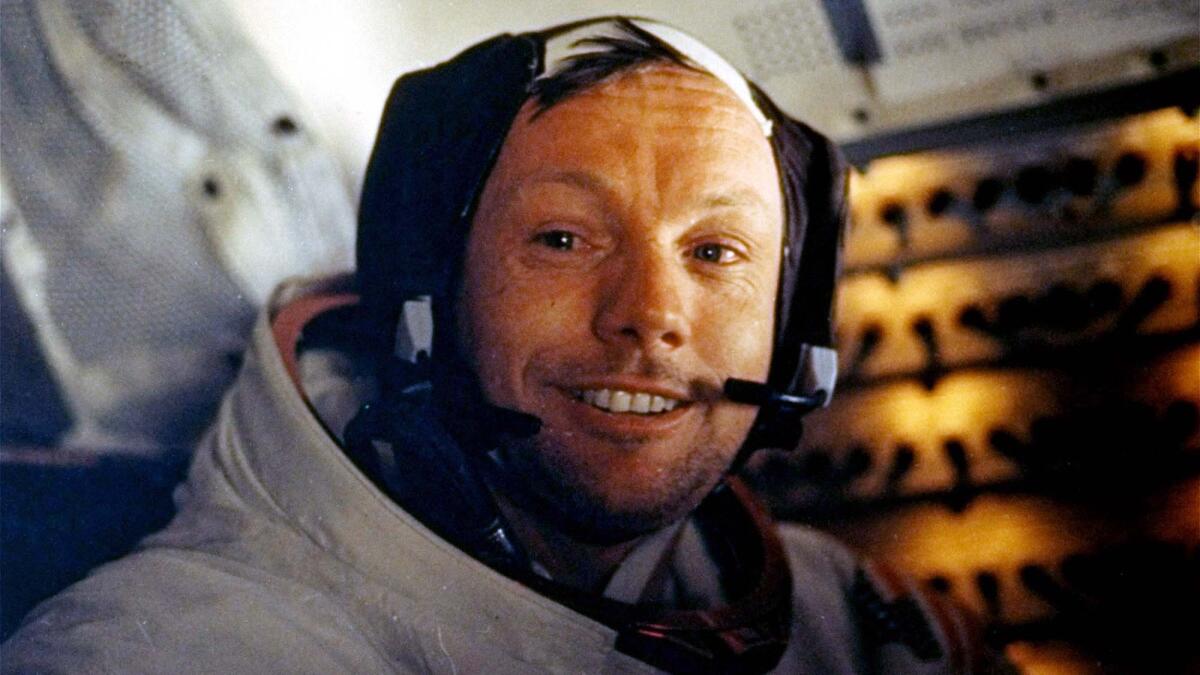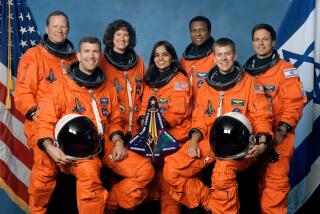The moon landing: the TV show of the (half) century
- Share via
We went to the moon on television.
Fifty years ago, on July 20, 1969, as the climax to a long-running series that began with President Kennedy’s famous 1962 called shot — “We choose to go to the moon in this decade,” a sound bite that seems to have found its way into nearly every related documentary since — men walked on the moon. More than half a billion people, about 14 percent of the global population, watched in more or less real time from Earth — the delay in signal from the moon a mere 1.25 seconds, not including the time it took to reach one’s own TV. I was at my best friend Brian’s, watching in a room with the curtains drawn against the dying light of the summer evening for maximum involvement.
Television was born as a live medium, but by the 1960s, few things happened live on it. Growing up in Los Angeles, nearly everything we saw, including the evening news, was prerecorded. Space launches were not. They were early-morning events, history in the making, which I was roused from bed to watch. I see myself now as I was then, in pajamas, overlooking a bowl of presweetened cold cereal. By the time of Apollo 11, I was getting myself up, and no longer watching in pajamas, but the cereal would have been there.
It was a Cold War story in its origins, but it was poetry too — humans floating in the empyrean void, the dance of pens and water droplets in zero G. And it was also a Thrilling Adventure (a race! for space!), starring astronaut heroes Hollywood could not have cast better. Even when they weren’t, strictly speaking, young — the Apollo 11 astronauts were all in their late 30s — they were youthful, fit, attractively soft-spoken and matter-of-fact after the fashion of Gary Cooper, Henry Fonda or James Stewart. As a viewer understood it, they were going to the moon, not (just) for any kind of geopolitical or practical advantage but because it was there.

There was something soft-spoken and matter-of-fact in the presentation too, the hectoring graphics and screens within screens of modern news being still a thing of the far future. Simplicity only amplified the occasion. “Man on the moon — aw, gee,” said Walter Cronkite, whose aura of authority has graced no anchor since, when the lunar module set down in the Sea of Tranquility. He took off his glasses, and rubbed his hands in delight. “Whew, boy,” he said, and that was enough.
It wasn’t the only real-life show on television. There was something in the happenstance of my own coming-to-consciousness that mirrored the dark progress of the decade: Vietnam and the antiwar movement became staples of the evening news, and the fragile fantasies of the Summer of Love collapsed into the chaos of 1968, with its assassinations and street fighting — culminating in the rude and bloody televised miniseries that was the Democratic National Convention. “The whole world is watching,” protesters chanted.
A cornucopia of space race documentaries greets the 50th anniversary of the moon landing.
Earlier that year, Cronkite, on the basis of his own on-the-ground reporting, took time on the CBS Evening News to declare Vietnam “a stalemate,” which some credit as turning the tide of public opinion against the war: “If I’ve lost Cronkite,” President Johnson is said to have said, “I’ve lost Middle America.”
Now, ready-when-you-are cable news means television is always more or less live, or ready to be live. That CNN and MSNBC and Fox News run around the clock — not to mention the perpetually present quasi-journalism of social media — ensures other network programming will rarely be interrupted for breaking news. It also means, in a strange way, that breaking news, even as it comes in torrents, has been diluted, devalued.
That the Watergate hearings and the Iran-Contra hearings, for example, were carried live on network broadcast television, in a time when that’s all the TV there was, gave them an aura of importance relative to their actual importance. If you were watching TV on July 20, 1969, you were watching Neil Armstrong take that step. A relative handful of people, unable to winnow fact from fiction, have claimed it was all fake, but we are living in a time in which those very words — fact, fiction — have for many lost their meaning. Reality, “reality,” news, fake news: Everything has gone out of focus.
There was a dramatic drive to the space program — in television terms, it was both episodic and long-arc — a progress marked by sometimes tragic reversals: Project Apollo began with the death of three astronauts in a training exercise. The landing itself was both a beginning, and the beginning of an end: There were subsequent moon landings, and increasingly better transmissions and new cool machines — hello, Lunar Roving Vehicle. (The Apollo 11 episode comes just halfway through HBO’s 1998 epic, 12-episode miniseries “From the Earth to the Moon,” currently available to view.) But everything after Neil Armstrong’s step for man/leap for mankind was a denouement, ever less marvelous. We knew it could be done. Apollo ran for another three years, until it was canceled in 1972.
The Space Shuttle program, which launched in 1976, did form a prosaic sequel. (Its great, tragic television moment came in 1986, when, 73 seconds into its 10th flight, the Challenger exploded.) But the more significant event, perhaps, came the following year, when “Star Wars” conquered the Earth. Through the nearly half-century since humans have left Earth’s orbit for its lonely, silent satellite, we have been going endlessly to special-effects space, gaudy and noisy and choked with interstellar traffic, crowding out the blurry, black-and-white images that fell to Earth 50 years ago. There is talk of going back now for real, to the moon and to Mars. Audiences too young to recall the original may be ready for the reboot.
More to Read
The complete guide to home viewing
Get Screen Gab for everything about the TV shows and streaming movies everyone’s talking about.
You may occasionally receive promotional content from the Los Angeles Times.







